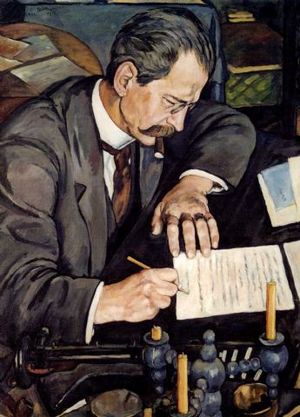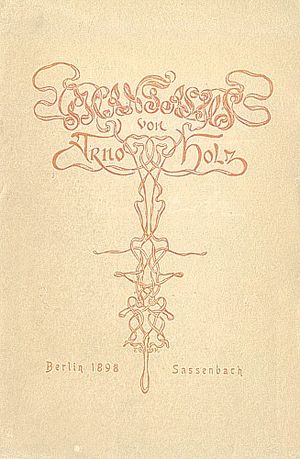Arno Holz facts for kids
Quick facts for kids
Arno Holz
|
|
|---|---|

Arno Holz, painted by Erich Büttner
|
|
| Born | 26 April 1863 Rastenburg, East Prussia |
| Died | October 1929 Berlin |
| Resting place | Friedhof Heerstraße |
| Occupation | Poet, writer, playwright |
| Signature | |
 |
|
Arno Hermann Oscar Alfred Holz (born April 26, 1863 – died October 1929) was a German poet and playwright. He was known for his realistic writing style. His most famous work is the poetry collection Phantasus (1898). He was even nominated for the Nobel Prize in Literature nine times!
Contents
Early Life and Career
Arno Holz was born in Rastenburg, which was then in East Prussia. Today, this place is called Kętrzyn in Poland. His father, Hermann Holz, was a pharmacist. In 1875, when Arno was 12, his family moved to the big city of Berlin.
After finishing school, Holz started working as a journalist in 1881. However, he soon decided to become a full-time writer. He often faced money problems throughout his life.
Joining the Naturalist Movement
In Berlin, Holz connected with a group of writers called the "naturalist club Durch". Here, he met the famous writer Gerhart Hauptmann. Naturalism was a style of art and literature that aimed to show life exactly as it was, even the difficult parts.
In 1885, Holz won the Schiller Prize for his poetry collection, Buch der Zeit (which means Book of Time). Around this period, he was very interested in Darwinism, a scientific theory about how living things change over time.
Working with Johannes Schlaf
From 1888, Holz worked closely with a writer and translator named Johannes Schlaf. Together, they came up with a new idea called "consistent naturalism." They wrote about this idea in their book, Art: its Nature and its Laws.
The "Art Formula"
Holz and Schlaf wanted to make art as real as possible. They believed art should describe things exactly. They even had a formula for it:
-
- Art = Nature − x
In this formula, x stands for the materials or changes needed to create the art. Their goal was to make x as small as possible. This meant art should be almost identical to nature.
Plays and "Second by Second Style"
Holz and Schlaf tried out their ideas in their plays, Papa Hamlet and Die Familie Selicke. They published these plays using a made-up name, Bjarne P. Holmsen. These plays were first performed in 1890.
To make their art super realistic, they used a style called "second by second style" (German: Sekundenstil). This meant they described every tiny detail, moment by moment, to show how people lived, especially those facing hardship.
Many critics didn't like Papa Hamlet at first. But some, like the writer Theodor Fontane, thought it was very artistic and important.
A Disagreement and New Ideas
Later, Holz and Schlaf argued about the money they made from their plays. Holz felt he had done more of the artistic work. This disagreement led to them no longer working together.
After this, Holz started experimenting even more with poetry. He wanted to write poems without traditional rhymes. He believed poems should have an "inner rhythm" instead of strict rules. He explained these ideas in his book, Revolution in Poetry (1899).
Later Life and Masterpieces
In 1893, Arno Holz married Emilie Wittenberg. They had three sons together.
The Phantasus Collection
In 1898, Holz published his most famous work, the poetry book Phantasus. This book showed off his amazing skill with language. It described the lives of struggling poets in his own neighborhood in Berlin, called Wedding.
Holz worked on these poems throughout his life, often changing them and making them better. A special thing about these poems is how they look on the page. All the lines are centered, making both the left and right edges uneven. This was very unusual for books at that time.
Here's an example from Phantasus about a church in his hometown:
...
landfernhin schauenden, landfernhin lugenden, landfernhin
sichtbaren
Burgbelfriedtürme
der massig, der mächtig, der
wuchtig
der
sturmtrotzig, ehrwürdig, bollwerkkühn,
letztzufluchtstark
stolzen,
feldsteinuntermauerten, ziegelstumpfbraunrötlichen,
berghügelkrönenden,
strebepfeilerigen, sternkreuzgewölbigen,
buntfensterigen
Sankt
Georgenkirche.
Other Successful Works
In 1903, Holz wrote Songs on an old Lute. This book was inspired by poetry from the Baroque era. He later made this book bigger and called it Dafnis. It was published by Reinhard Piper and became one of Holz's few financial successes.
Holz also gained recognition for his play Traumulus (1904). This was the first of five plays he created with his friend Oskar Jerschke. Traumulus was performed in many theaters. Later, in 1935, it was even made into a film called The Dreamer.
Between 1910 and 1929, Arno Holz lived in the Schöneberg area of Berlin. He divorced and remarried in 1926. He passed away in October 1929 and is buried in an honored grave at the Friedhof Heerstrasse cemetery. Several monuments have been built to remember him.
See also
 In Spanish: Arno Holz para niños
In Spanish: Arno Holz para niños



